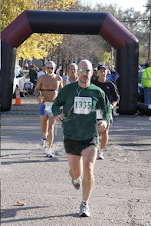When I ran my first (and so far only) marathon this past November, I felt great for more than 15 miles. And by great, I mean really great. I knocked out the first 13.1 in way less than two hours and I thought, with a pace like that, I'd be well on my way to breaking the four-hour goal I'd arbitrarily set for myself. In fact, part of me thought a finishing time of a little over three and a half hours was even an outside possibility.
My hip, though, felt otherwise. Just past Mile 15 I started to feel something—a dull throb that started on the outside of my left hip. That ache quickly became a sharp pain, and no matter how great I felt in the rest of my body (my lungs, my feet) that pain wasn't going away. Pretty soon it was all I could think about. I didn't want to stop, but by Mile 18 I had no choice.
I tried to stretch, but nothing worked. Nothing I did really addressed the root of the problem. I tried to do the few hip exercises I knew, but they didn't get to the source of the pain. Whatever ailed me seemed to be deeper than my muscles. I pressed on, determined to finish this race I'd trained so long for, but as I watched the four-hour pacesetters, then the 4:15 group pass by, I knew a good time wasn't in the cards. I limped over the finish line in just under four and a half hours.
After the marathon, I came home and showered, and while my hip still hurt a bit, it wasn't debilitating like it was during the race. In fact, a couple of days later I ran on it again—just for a few miles—and I felt fine. And that was frustrating. How could a 38-year-old in good physical shape with no other ailments suddenly start experiencing these problems? And how could these symptoms go away as quickly as they started?
I researched a bit, and while I've not completely diagnosed the problem, I had a theory. Last week, I tested it out.
On Wednesday I ran a 12-miler on some great country roads by my house. I love runs like that, out in the middle of nowhere. As I usually do for safety, I started my run facing traffic, but after about six miles, I felt the beginnings of that same hip pain. Rather than stop, though, I simply switched to the other side of the road so I was running with traffic (thankfully the roads I run are not heavily traveled). What was interesting was that, instead of intensifying, the pain in my hip abated. After a few more miles, it was gone. All from simply switching to the other side of the street.
Funny thing about roads that I've since learned, especially roads out in the country: They have a high "crown" to them, a high spot in the center to allow water to run off to the sides when it rains. Run long enough on one side of those roads—say, facing traffic with your left leg lower than your right—and eventually you're going to feel some pain.
Turns out, I'm not the first to discover this. An article from the Running Times discusses how the iliotibial (IT) band, which starts in the pelvis and runs along outside of the leg, can be aggravated by just such an activity as running along the side of road. When I switched to the other side, I was able to alleviate the problem by taking that constant pressure off my left hip.
Now I'm not sure if this is the medically correct answer to my problem. All I know is that when I switched sides of the road, the pain went away. I was able to run 12 miles pain free. It's definitely something I'm going to keep tabs on in the future.
(Oh, and to keep you up on my calf, luckily it was a small(ish) pop. It still hurts a bit, but I'm going to try running on it this evening at the gym. Wish me luck.)
Happy running.
First Cousin
1 week ago


No comments:
Post a Comment